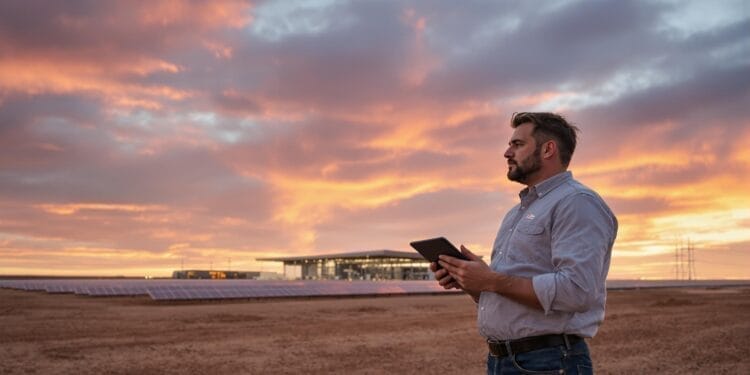Bitcoin mining. It’s often painted as an energy hog, a digital furnace guzzling power. But what if it could actually *help* the energy industry? Spencer Marr, the president of Sangha Renewables, thinks it can. And he’s not talking about some pie-in-the-sky future. He’s building it now, one solar farm at a time.
- Sangha Renewables is working to use excess energy to power Bitcoin mining operations, creating a profitable use for otherwise wasted electricity.
- Bitcoin mining could establish a global benchmark for electricity prices, similar to how Brent crude functions for oil.
- Sangha offers energy companies a turnkey solution for Bitcoin mining, buying excess power without requiring them to become Bitcoin experts.
Marr had a bit of a eureka moment back in 2017, during the last crypto boom. He wondered if all that wasted energy – electricity generated but with nowhere to go – could be put to work. Not just used, but *profitably* used. The idea? Turn excess power into Bitcoin. Simple, right? Well, convincing energy companies to jump on board hasn’t been. They’re cautious, understandably. Bitcoin still feels…weird to a lot of them. But the recent arrival of Bitcoin ETFs, backed by big Wall Street names like BlackRock, is changing the conversation. Suddenly, it’s not just about digital funny money anymore.
A Global Price Tag for Electricity?
Marr envisions something bigger than just a few mines humming away next to solar farms. He thinks Bitcoin mining could eventually create a global index for the price of electricity, much like Brent crude does for oil. Imagine a world where the value of a kilowatt-hour is instantly comparable, no matter where it’s produced. It sounds ambitious, maybe even a little crazy. But Marr, a lawyer turned renewable energy advocate, has a knack for seeing possibilities others miss.
Sangha isn’t asking energy companies to become Bitcoin experts overnight. They’re offering a deal: Sangha will build and operate the mining facility, buying electricity directly from the producer. No upfront costs for the energy company, just a guaranteed buyer for power that might otherwise be worthless. “Wait, so what’s the catch?” Marr says they’re asked constantly. His answer? “There’s no catch. This is real.” It’s a surprisingly straightforward pitch in a world of complex financial instruments.
The problem Sangha is tackling is real. Renewable energy sources like wind and solar are… intermittent. A wind farm can generate a ton of power on a windy night, but what if nobody needs it? Unlike oil, you can’t just store electricity easily (batteries are expensive). Often, these companies end up *paying* to get rid of excess power. It’s a bizarre situation, but a common one. And that’s where Bitcoin mining comes in. It’s a buyer of last resort, a way to turn wasted electrons into something valuable.
Mike Cohen, CEO of Pow.re, a company investing in renewable energy grids, puts it plainly: “The grid was designed for stable energy generation in proximity to where it would be consumed. Wind and solar are geographically dependent.” Bitcoin mining doesn’t care where the electricity comes from, as long as it’s cheap. And it can be switched on and off quickly, unlike data centers that need constant uptime. That flexibility is a big advantage.
Sangha has a deal in the works with a major renewable energy company in West Texas – 19.9 megawatts, enough to power roughly 4,000 homes. The mine is expected to go live in spring 2025, and projections suggest it could boost the site’s revenue by 3.7%. It’s a small-scale pilot project, but Marr believes it’s proof of concept. He’s already talking to other energy giants, and the interest is growing.
West Texas and Beyond
Scaling up won’t be easy. Regulatory hurdles and the need for significant investment are major challenges. Marr points out that you can’t easily build a mine larger than 20 megawatts without jumping through a lot of hoops. But the potential rewards are substantial. The West Texas facility is projected to generate $42 million in revenue in its first year and mine around 900 Bitcoin over the next decade. Investors are being offered a potential 25% to 50% discount on the price of Bitcoin.
This isn’t just about profits, though. Marr believes Bitcoin mining can help accelerate the transition to renewable energy by making green projects more financially viable. It’s a way to reduce reliance on government subsidies and create a more sustainable energy future. Other companies, like Satoshi Energy, are exploring similar models. Andrew Myers, founder of Satoshi Energy, welcomed Sangha’s efforts, quipping, “Welcome to West Texas!”
The idea of energy companies operating their own Bitcoin mines isn’t entirely new, but Marr’s approach – offering a turnkey solution with no upfront costs – is innovative. It’s a way to overcome the inertia and skepticism that often plague the energy industry. And if Marr is right, it could fundamentally change the way we think about electricity, turning it from a localized commodity into a globally traded asset. It’s a long shot, maybe. But then again, Bitcoin itself was once considered a long shot.

















